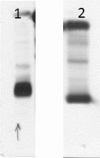Old but Still Relevant: High Resolution Electrophoresis and Immunofixation in Multiple Myeloma
- PMID: 26855502
- PMCID: PMC4733669
- DOI: 10.1007/s12288-015-0605-3
Old but Still Relevant: High Resolution Electrophoresis and Immunofixation in Multiple Myeloma
Abstract
Introduction: High resolution electrophoresis (HRE) and immunofixation (IFX) of serum and urine are integral to the diagnostic work-up of multiple myeloma. Unusual electrophoresis patterns are common and may be misinterpreted. Though primarily the responsibility of the hematopathologist, clinicians who are responsible for managing myelomas may benefit from knowledge of these. In this review article we intend to discuss the patterns and importance of electrophoresis in present day scenario.
Methods: Patterns of HRE and IFX seen in our laboratory over the past 15 years were studied.
Results: Monoclonal proteins are seen on HRE as sharply defined bands, sometimes two, lying from γ- to α-globulin regions on a background of normal, increased or decreased polyclonal γ-globulins, showing HRE to be a rapid and dependable method of detecting M-protein in serum or urine. Immunofixation complements HRE and due to its greater sensitivity, is able to pick up small or light chain bands, not apparent on electrophoresis, including biclonal disease even when electrophoresis shows only one M-band. Special features liable to misinterpretation are discussed. Familiarity with the interpretation of the varied patterns seen in health and disease is essential for providing dependable laboratory support in the management of multiple myeloma.
Keywords: High resolution electrophoresis; Immunofixation; Myeloma.
Figures



Similar articles
-
Quantification by Ultrafiltration and Immunofixation Electrophoresis Testing for Monoclonal Serum Free Light Chains.Lab Med. 2020 Nov 2;51(6):592-600. doi: 10.1093/labmed/lmaa012. Lab Med. 2020. PMID: 32285117
-
Evaluation of Double M-Band on Serum Protein Electrophoresis Simulating Biclonal Gammopathy: A Case Report.Indian J Clin Biochem. 2022 Apr;37(2):247-249. doi: 10.1007/s12291-020-00929-y. Epub 2021 Apr 8. Indian J Clin Biochem. 2022. PMID: 35463098 Free PMC article.
-
MALDI-TOF mass spectrometry can distinguish immunofixation bands of the same isotype as monoclonal or biclonal proteins.Clin Biochem. 2021 Nov;97:67-73. doi: 10.1016/j.clinbiochem.2021.08.001. Epub 2021 Aug 9. Clin Biochem. 2021. PMID: 34384797
-
Urine Protein Immunofixation Electrophoresis: Free Light Chain Urine Immunofixation Electrophoresis Is More Sensitive than Conventional Assays for Detecting Monoclonal Light Chains and Could Serve as a Marker of Minimal Residual Disease.Lab Med. 2023 Sep 5;54(5):527-533. doi: 10.1093/labmed/lmac155. Lab Med. 2023. PMID: 36857478 Review.
-
Diagnostic performance of routine electrophoresis and immunofixation for the detection of immunoglobulin paraproteins (M-Proteins) in dogs with multiple myeloma and related disorders: Part 2-Toward improved diagnostic performance.Vet Clin Pathol. 2021 Jun;50(2):249-258. doi: 10.1111/vcp.12940. Epub 2021 Apr 14. Vet Clin Pathol. 2021. PMID: 33855710 Review.
Cited by
-
Immunoglobulin D-λ/λ biclonal multiple myeloma: A case report.World J Clin Cases. 2021 Apr 16;9(11):2576-2583. doi: 10.12998/wjcc.v9.i11.2576. World J Clin Cases. 2021. PMID: 33889623 Free PMC article.
-
Excess Free Light Chains in Serum Immunofixation Electrophoresis: Attributes of a Distinctive Pattern.Indian J Hematol Blood Transfus. 2018 Oct;34(4):632-635. doi: 10.1007/s12288-018-0926-0. Epub 2018 Jan 31. Indian J Hematol Blood Transfus. 2018. PMID: 30369732 Free PMC article.
-
Changing Times for the IJHBT.Indian J Hematol Blood Transfus. 2016 Mar;32(1):1-2. doi: 10.1007/s12288-015-0631-1. Epub 2015 Dec 28. Indian J Hematol Blood Transfus. 2016. PMID: 26855500 Free PMC article. No abstract available.
-
Navigating the clinical landscape: Update on the diagnostic and prognostic biomarkers in multiple myeloma.Mol Biol Rep. 2024 Sep 9;51(1):972. doi: 10.1007/s11033-024-09892-w. Mol Biol Rep. 2024. PMID: 39249557 Review.
References
-
- Harding SJ, Mead GP, Bradwell AR, Berard AM. Serum free light chain immunoassay as an adjunct to serum protein electrophoresis and immunofixation electrophoresis in the detection of multiple myeloma and other B-cell malignancies. Clin Chem Lab Med. 2009;47:302–304. doi: 10.1515/CCLM.2009.084. - DOI - PubMed
-
- Durie BG, Harousseau JL, Miguel JS, Blade J, Barlogie B, Anderson K, Gertz M, Dimopoulos M, Westin J, Sonneveld P, Ludwig H, Gahrton G, Beksac M, Crowley J, Belch A, Boccadaro M, Cavo M, Turesson I, Joshua D, Vesole D, Kyle R, Alexanian R, Tricot G, Attal M, Merlini G, Powles R, Richardson P, Shimizu K, Tosi P, Morgan G, Rajkumar SV. International uniform response criteria for multiple myeloma. Leukemia. 2006;20:1467–1473. doi: 10.1038/sj.leu.2404284. - DOI - PubMed
-
- Anand M, Kumar R, Sharma OD. Economical choices in setting up a diagnostic myeloma laboratory. Indian J Pathol Microbiol. 2004;47:506–508. - PubMed
-
- Keren DF, Warren JS. Diagnostic immunology. Maryland: Lippincott Williams and Wilkins; 1992.
Publication types
LinkOut - more resources
Full Text Sources
Other Literature Sources
Miscellaneous
